You've just had another perfect day on the water. The Miami skyline shining in the distance, the gentle rocking of your boat beneath you, and that feeling of freedom that only comes when you're out on the open water. But while you're making memories, something else is happening to your boat, something you can't see.
Saltwater, it's the quiet enemy of every boat in South Florida. While it makes the waters we love to boat in, it's also secretly working against your boat 24/7. That clear, blue water around Key Biscayne or Miami Beach? It's actually a strong corrosive that's always trying to break down your boat, bit by tiny bit.
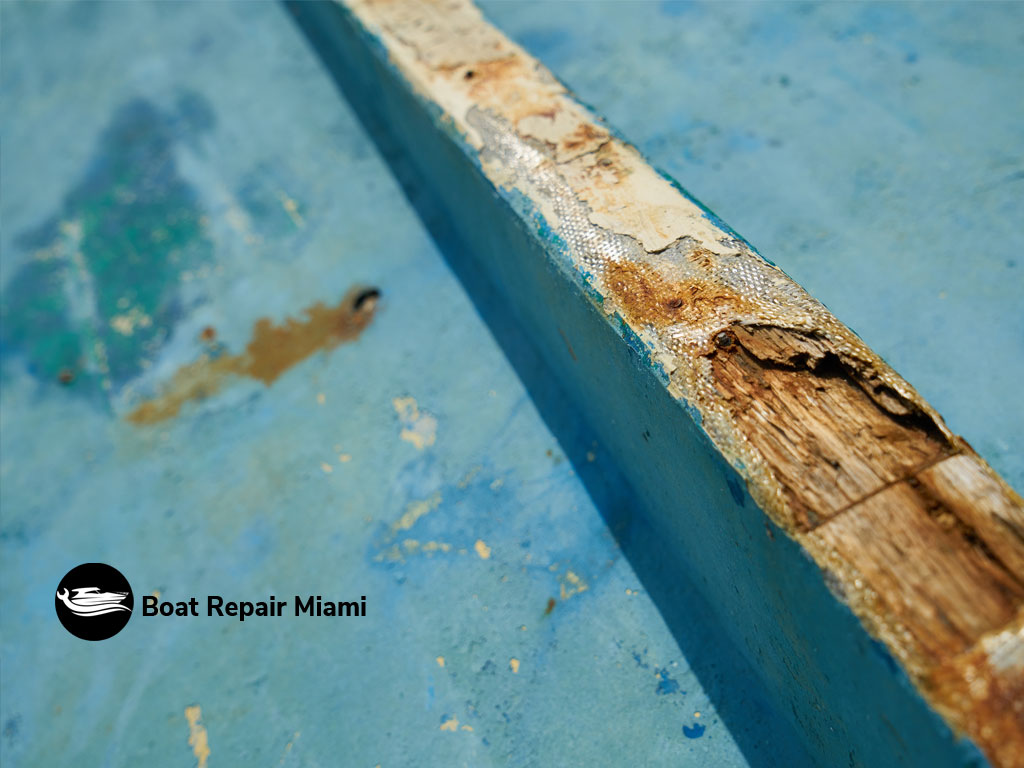
Here's the thing about saltwater damage, it doesn't show up with warning lights or sudden breakdowns. It works slowly, hiding until one day you're facing a repair bill that makes your eyes water more than the ocean spray.
As boaters who've spent years in South Florida waters, we've seen how saltwater turns small problems into big headaches. From Fort Lauderdale to West Palm Beach, the mix of salt, sun, and humidity creates the perfect storm for faster boat damage.
We'll show you what's really happening to your boat when it's in our beautiful but harsh waters. You'll learn about the weak spots you might be missing, the warning signs of trouble, and most importantly, how to protect your boat without spending every weekend on upkeep.
Whether you're cruising in North Miami Beach or fishing off Port Everglades, understanding saltwater's hidden effects isn't just about keeping your boat's value, it's about keeping you safe and happy on the water for years to come.
Let's talk about saltwater damage, not to scare you, but to help you keep boating worry-free in our South Florida paradise.
How Saltwater Damages Your Boat
Ever wonder why boats in freshwater lakes can last for decades with few problems, while ocean boats need constant care? It all comes down to basic science, with big effects on your boat.
Saltwater isn't just water with salt added. It's full of minerals that create the perfect setting for chemical reactions. When these minerals touch the metals on your boat, they start a process that slowly eats away at your boat's parts.
Here in Miami, we face three big problems. According to experts at the Association for Materials Protection and Performance, saltwater conducts electricity about 800 times better than fresh water. This speeds up the damage process a lot. When you add our year-round heat and humidity, you've got a recipe for faster damage that's unique to South Florida.
Think of saltwater like tiny workers that never stop breaking things down. Even when your boat looks dry, invisible salt crystals stay behind, pulling moisture from the air and continuing their harmful work. A recent study in the Marine Technology Society Journal found that boats in warm saltwater areas like ours get damaged up to 40% faster than those in cooler coastal regions.
What makes this extra tricky is that the damage often starts in places you can't easily see, inside electrical connections, under mounting hardware, or in the small spaces of your engine parts. By the time you notice visible damage, the problem has likely been growing for months.
It's a bit like termites in a house, by the time you see the signs, they've already been eating away at your structure for quite some time. The difference? Saltwater works even faster, and it attacks all materials. Metal rusts, fiberglass gets bubbles, seats rot, and electrical systems fail, all from the same hidden enemy.
Parts of Your Boat Most at Risk from Saltwater
Not all parts of your boat handle saltwater the same way. Knowing which areas need the most attention can save you thousands in repairs and many hours of frustration.
Metal Parts That Break Down First
Metal fittings, rails, and hardware usually show signs of saltwater damage first. Stainless steel, despite its name, isn't really stainless in ocean water, it just lasts longer than other metals. In Miami's harsh waters, even good quality stainless steel starts to pit and rust over time.
Aluminum parts are especially at risk. That trim on your outboard? The T-top supports? The swim platform? All prime targets. Aluminum rusts differently than other metals, often forming a white, powdery substance that weakens the metal from the inside. We've seen cases where aluminum parts that looked fine on the outside crumbled when touched, a scary thought if that part is important for your boat's safety.
When Electrical Problems Turn Dangerous
If there's one area where saltwater damage can go from annoying to dangerous quickly, it's your boat's electrical system. Electrical connections are like candy to saltwater. The mix of different metals close together creates a perfect setup for galvanic corrosion, where one metal breaks down to protect another.
The wiring on your outboard, the back of your electronics, battery terminals, and switch panels are all high-risk areas. We've seen countless boats in Palm Beach and Fort Lauderdale with electrical gremlins that all traced back to saltwater getting in. One small rusted connection can cause system-wide failures that are very hard to find.
When electrical issues come up, you need a skilled professional who understands boat electrical systems. Learn how to choose a good boat electrician who can properly fix saltwater-related electrical problems.
Engine Problems That Empty Your Wallet
Your engine might seem sealed and protected, but it's actually one of the most at-risk systems on your boat. Saltwater is pulled through the engine for cooling, leaving deposits and starting rust from the inside out. Exhaust parts, risers, and cooling passages are especially vulnerable.
In Miami's warm waters, we see faster rust in these systems compared to cooler areas. The heat speeds up the chemical reaction, meaning parts that might last 5-7 years up north might need replacement in 3-4 years here. That's a big difference in maintenance costs that many new South Florida boaters don't expect.
Regular engine maintenance and repair is essential to fight these effects and keep your boat running well despite the harsh saltwater.
When Your Hull Starts Breaking Down
While fiberglass doesn't rust like metal, it's not safe from saltwater damage. Over time, saltwater can get through the gelcoat, leading to blistering and delamination. This is especially common in boats kept in the water year-round in places like Miami Beach or Key Biscayne.
What's particularly sneaky about hull damage is that it often happens below the waterline where you can't see it. By the time you notice something's wrong, the repair bill has already grown a lot. We've seen boats less than five years old needing major fiberglass repair in Miami because basic maintenance was skipped.
Why Your Boat Gets Slower Over Time
Your propeller and running gear are always in contact with saltwater, making them very vulnerable. Even small amounts of rust on a prop can greatly affect performance and fuel use. A rusted propeller doesn't just push your boat slower, it makes your engine work harder, shortening its life.
Zinc anodes (sometimes called "sacrificial zincs") are designed to rust first, protecting other underwater metals. But in South Florida's warm waters, these anodes wear away faster than in cooler regions. We've seen boats come in from North Miami Beach with completely gone zincs and severe damage to running gear that could have been prevented with more frequent checks.
Warning Signs of Saltwater Damage
Catching saltwater damage early can mean the difference between a quick fix and a major overhaul. Here are the subtle signals your boat is sending when saltwater is winning the battle.
Early Warning Signs Most People Miss
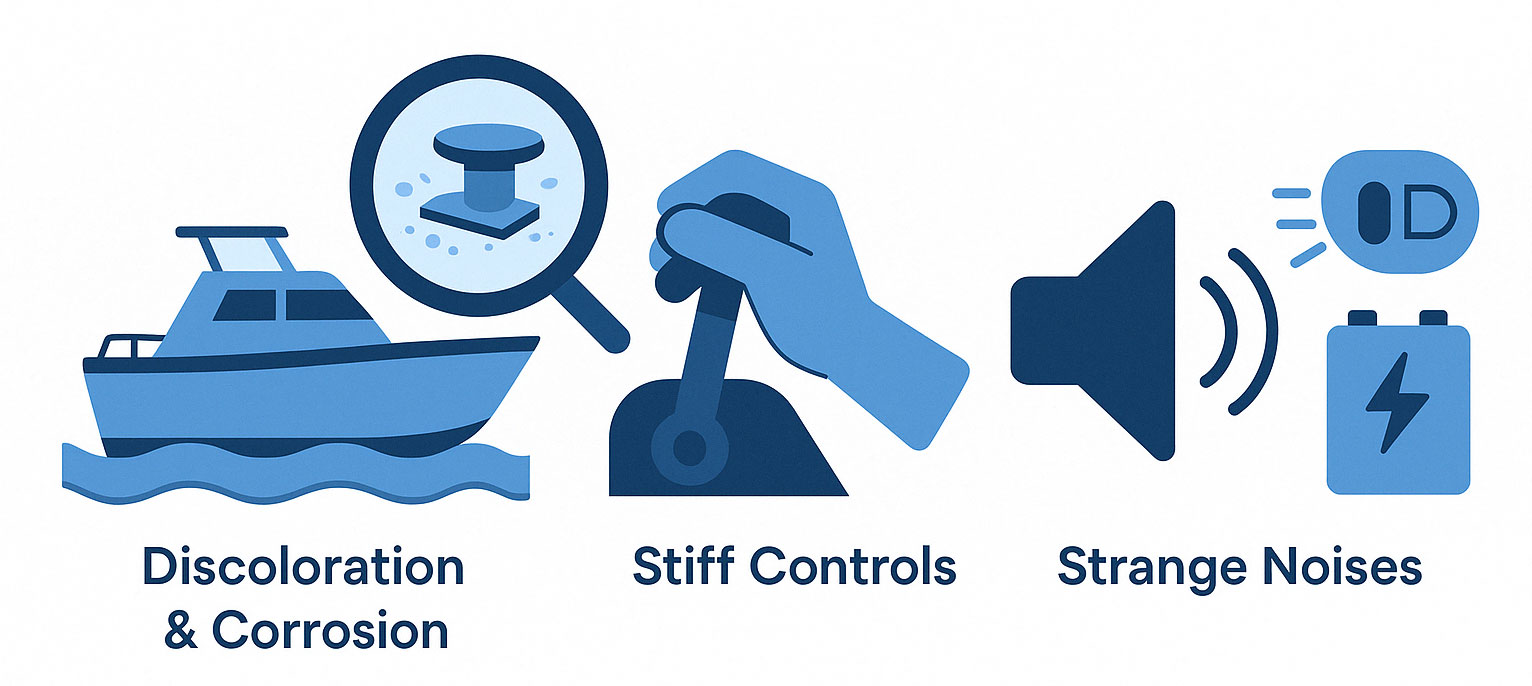
Before rust becomes obvious, there are several warning signs that something's wrong. Discoloration around metal fittings, a slight greenish tint around bronze or brass, or a white powdery substance around aluminum, is one of the earliest signs. These changes might seem just cosmetic, but they're actually the first stage of a much bigger problem.
Another early warning: unusual resistance in mechanical controls. If your throttle feels sticky or your steering seems slightly stiffer than usual, saltwater may have begun working its way into these systems. Don't just add lubricant and forget about it, that's like putting a bandage on a splinter without removing it first.
When Your Boat Starts Making Weird Noises
Your boat will often tell you something's wrong before you can see it. Unusual sounds, grinding, clicking, or whining that wasn't there before, need immediate attention. In the waters around Port Everglades and Fort Lauderdale, we've diagnosed serious problems that began as nothing more than a strange new sound during operation.
Electrical systems have their own warning signs. Dimming lights, on-and-off failures, or electronics that need to "warm up" before working properly often point to rust in connections or wiring. These symptoms tend to get worse in high humidity, something we have plenty of in South Florida.
Changes in Performance You Can't Ignore
A boat that suddenly uses more fuel, doesn't get up on plane as easily, or has lost its top speed is telling you something's wrong. These performance changes rarely happen overnight, they develop gradually as saltwater damage progresses, making them easy to miss if you're not paying attention.
In the waters off West Palm Beach and Palm Beach, where many boaters enjoy longer offshore trips, these performance issues can be particularly worrying. Being 20 miles offshore is not where you want to discover that a small, ignored problem has become a major one.
How Quickly Damage Gets Worse
Understanding how quickly saltwater damage progresses can help you recognize problems before they become emergencies. In South Florida's climate, here's a general timeline of what happens when saltwater exposure goes unchecked:
- 1-3 months: Initial surface rust begins on exposed metal parts
- 3-6 months: Electrical connections begin to degrade, intermittent issues appear
- 6-12 months: Significant rust visible on underwater metals, performance affected
- 1-2 years: Major systems begin failing, repair costs increase greatly
- 2+ years: Structural integrity may be compromised, boat value significantly reduced
This timeline speeds up if your boat sees heavy use in saltwater without proper rinsing and maintenance. A weekend warrior who boats every Saturday in Miami's waters without proper Monday maintenance might see year-two problems emerging in just months.
The True Cost of Ignoring Saltwater Damage
When it comes to saltwater damage, what you don't know can definitely hurt you, and your wallet. Let's break down the real costs of letting saltwater have its way with your boat.
What Saltwater Damage Really Costs
According to data from Rust Patrol's marine industry analysis, rust-related issues account for up to 50% of all boat maintenance costs nationwide. In South Florida's aggressive saltwater environment, that percentage climbs even higher. The average boat owner in Miami-Dade County spends between $2,000 and $5,000 each year addressing rust-related issues, and that's for boats that receive regular maintenance.
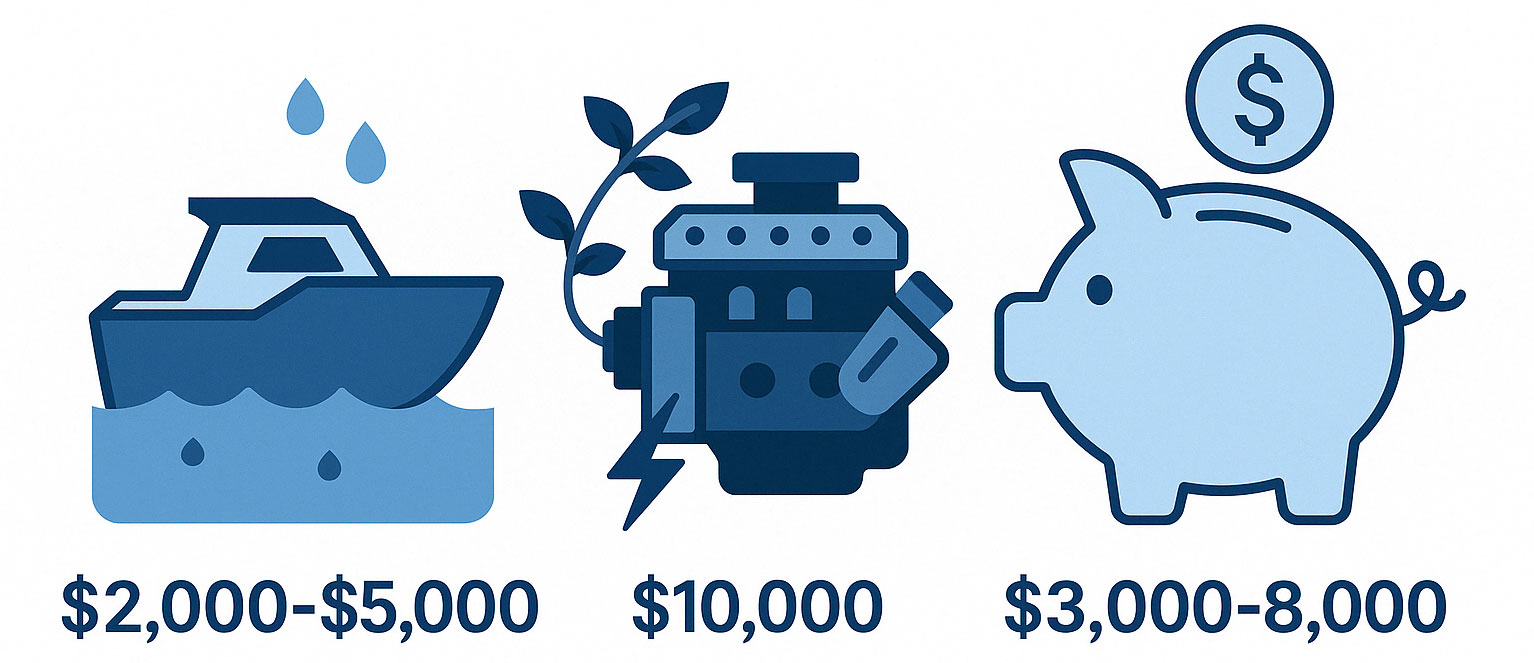
For those who neglect preventive care, the numbers become truly shocking. A major engine overhaul needed because of saltwater damage can easily exceed $10,000. Complete rewiring of rusted electrical systems? That's another $3,000 to $8,000 depending on your boat's complexity. And if structural components have been compromised, you're looking at repairs that can quickly exceed the boat's value.
Think of it like healthcare, you can pay a little now for prevention, or a lot later for the cure. According to Marine Depot Direct, new boat owners pay around $5,000-$8,000 per year in maintenance costs, but proper preventive care can significantly reduce these expenses over time. That's why investing in regular maintenance makes financial sense for any boat owner.
When Saltwater Damage Becomes Dangerous
Financial costs pale in comparison to the safety risks of unchecked saltwater damage. Rusted through-hull fittings can fail completely, leading to sinking. Electrical system failures can cause fires or leave you stranded. Steering or throttle control issues from rust can create dangerous situations in the busy waters around Miami Beach or Key Biscayne.
We've seen too many close calls where boaters narrowly avoided disaster because a saltwater-damaged part chose a bad moment to fail. The waters between Miami and the Bahamas are full of stories of boats that didn't make it back because maintenance was put off one too many times.
Why Your Boat Loses Value So Fast
Your boat is an investment, and saltwater damage speeds up value loss dramatically. A well-maintained 5-year-old boat might keep 60-70% of its original value. The same boat with visible signs of saltwater neglect? You're looking at 40% or less. On a $100,000 vessel, that's a difference of $20,000-$30,000 in resale value, far more than you'd spend on proper maintenance.
When potential buyers see stained gelcoat, rusted fittings, or signs of electrical issues, they don't just see the visible problems, they imagine what might be lurking beneath the surface. In South Florida's competitive boat market, vessels with signs of saltwater damage sit longer and sell for much less.
When Your Boat Stops Being Fun
Long before saltwater damage threatens your safety or sinks your boat's value, it takes a toll on performance. Rusted propellers can reduce fuel efficiency by 10-15%. Compromised engine components mean less power and more strain on the entire system. What was once a joy to drive becomes sluggish and frustrating.
For many boaters in Fort Lauderdale and Miami, their vessel is an escape, a source of joy and relaxation. When performance suffers, that joy diminishes. The true cost here isn't measured in dollars but in diminished experiences and memories not made because your boat isn't performing as it should.
Why Prevention Makes More Sense
Let's put this in perspective with some real numbers. A complete saltwater prevention program for a 25-foot boat in Miami waters might cost $1,200-$1,800 yearly, including regular rinses, protective treatments, zinc replacements, and inspections.
Compare that to just one major saltwater-induced repair, like replacing corroded engine components at $5,000-$8,000, and the math becomes clear. Prevention isn't just cheaper in the long run, it's also less disruptive to your boating lifestyle.
Protecting Your Boat from Saltwater Damage
Now that you understand the threat, let's talk about practical ways to protect your boat from saltwater's effects. These strategies work for boats of all sizes used in South Florida waters.
The Most Important Thing You Can Do
If there's one practice that makes the biggest difference in fighting saltwater damage, it's thorough freshwater rinsing after every use. This simple step removes salt before it can do its damage. But there's a right way and a wrong way to rinse.
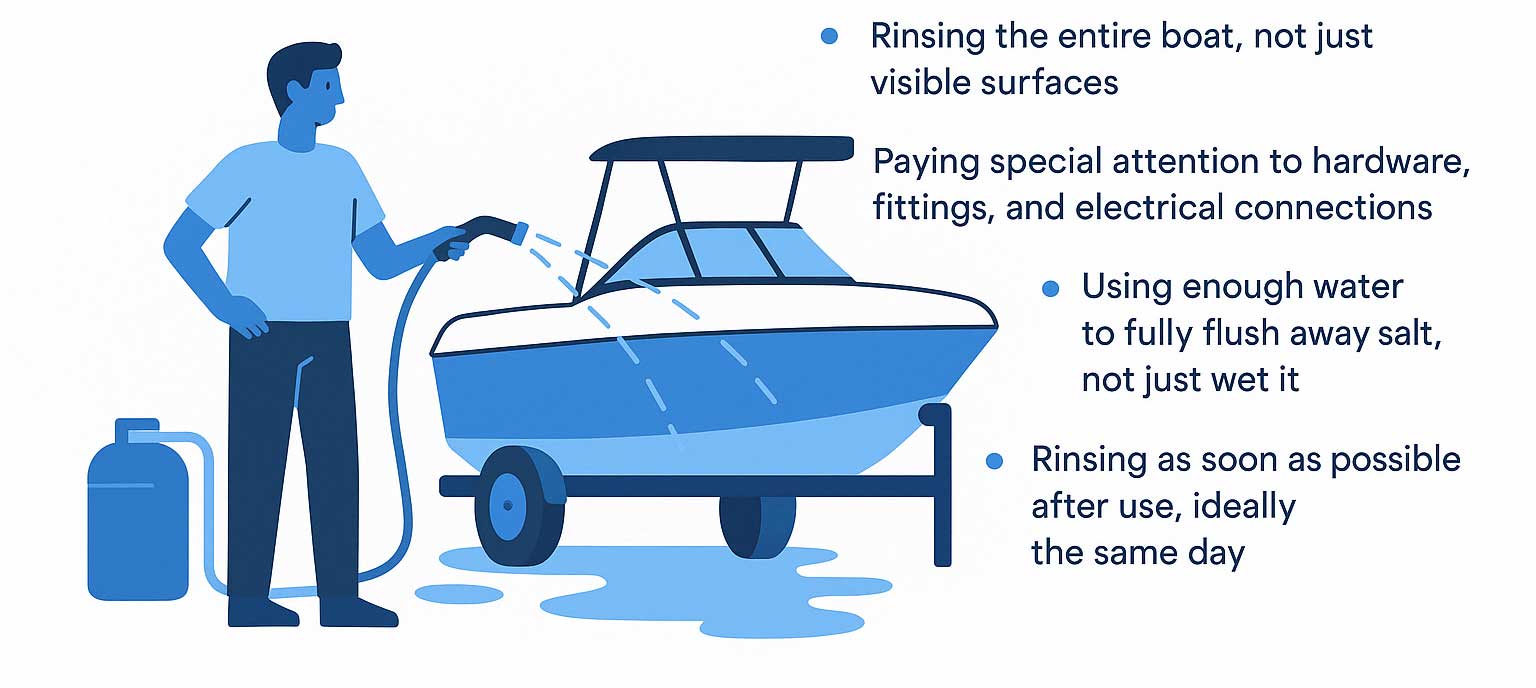
The right way includes:
- Rinsing the entire boat, not just visible surfaces
- Paying special attention to hardware, fittings, and electrical connections
- Using enough water to fully flush away salt, not just wet it
- Rinsing as soon as possible after use, ideally the same day
- Allowing the boat to dry completely after rinsing
For boats used in the waters around Miami and Key Biscayne, where salt concentration is particularly high, this post-use rinse is non-negotiable. We've seen dramatic differences in condition between regularly rinsed boats and those that get occasional or superficial rinses.
Protective Coatings That Actually Work
Beyond rinsing, protective coatings create a barrier between your boat and saltwater. Not all coatings are created equal, though. For South Florida boats, look for products specifically formulated for extreme marine environments.
For metal components, corrosion-inhibiting sprays that displace moisture and leave a protective film work well. Apply these to electrical connections, engine components, and hardware after thorough cleaning and drying.
For fiberglass and gelcoat, modern ceramic coatings offer superior protection compared to traditional waxes. While more expensive initially, their longer lifespan (often 1-2 years versus 2-3 months for wax) makes them cost-effective for boats used in Miami's harsh conditions.
The Zinc Solution
Sacrificial anodes (zincs) are your underwater metal's best friends. These pieces of metal are designed to corrode first, protecting more valuable metals through galvanic action. In South Florida waters, zincs need more frequent inspection and replacement than in cooler regions.
For boats kept in the water in places like Miami Beach or Fort Lauderdale marinas, checking zincs monthly is essential. Replace them when they're about 50% deteriorated, not when they're completely gone. The cost of new zincs is tiny compared to the underwater metals they protect.
Smart Storage Solutions
How and where you store your boat significantly impacts saltwater damage. Whenever possible, store your boat out of the water. Dry storage facilities in North Miami Beach and throughout South Florida offer protection from constant water contact.
If in-water storage is your only option, consider these protective measures:
- Use a quality boat lift if in shallow water
- Install a freshwater rinse system at your slip
- Use proper covers to prevent rain and dew from pooling
- Choose marinas with good water circulation rather than stagnant areas
- Consider bottom paint appropriate for your usage pattern
For boats stored in the water around Port Everglades or Palm Beach, where commercial traffic creates more water movement and potential contaminants, these protective measures become even more important.
Electrical System Protection
Electrical systems require special attention in saltwater environments. Beyond basic rinsing, these specific steps help prevent costly electrical failures:
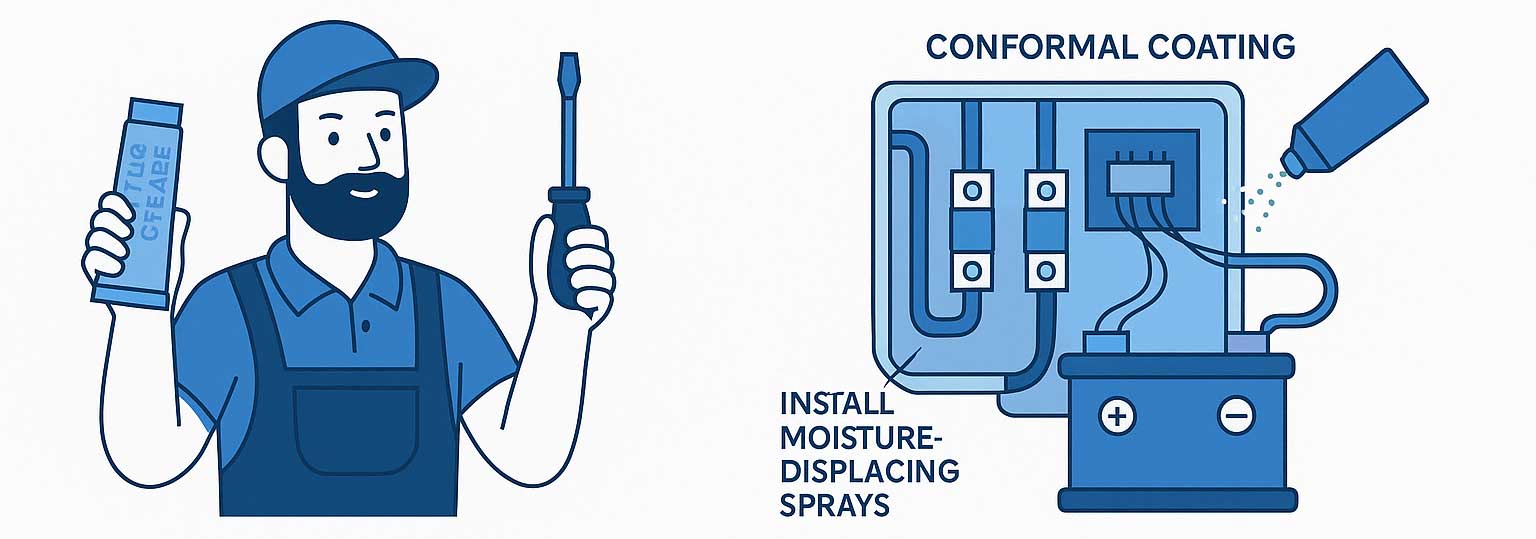
- Apply dielectric grease to all connections when installing or servicing
- Use marine-grade heat shrink with adhesive lining on all wire connections
- Install moisture-displacing sprays in electrical panels and junction boxes
- Consider conformal coating for circuit boards in critical electronics
- Use corrosion-inhibiting sprays on battery terminals and connections
For boats with extensive electronics used in the waters off Miami and Fort Lauderdale, these precautions aren't optional, they're essential for preventing the cascade of electrical failures that saltwater can cause.
Essential Maintenance Routines
Protecting your boat from saltwater damage isn't a one-time thing, it requires consistent attention through well-established routines. Here's how to structure your maintenance schedule for maximum protection in South Florida waters.
Weekly Checks That Save Your Boat
Even when your boat hasn't left the dock, salt air and humidity are hard at work. A weekly check-in takes just 30 minutes but can prevent thousands in damage:
- Rinse exterior surfaces with fresh water, even if the boat hasn't been used
- Wipe down metal surfaces with a rust inhibitor
- Check battery connections for early signs of rust
- Run the engine briefly if the boat is in the water (prevents growth on underwater components)
- Ensure covers and canvas are secure to prevent rain and dew accumulation
For boats kept at marinas in Miami Beach or Key Biscayne, where salt spray is constant, this weekly routine is non-negotiable. We've seen dramatic differences in condition between boats just a few slips apart based solely on whether this weekly maintenance happens.
Monthly Deep Checks That Find Problems Early
Once a month, set aside a few hours for a more thorough inspection:
- Check all sacrificial anodes and replace if 50% or more depleted
- Inspect all through-hull fittings for signs of rust
- Test all electrical systems and electronics
- Examine steering and throttle controls for smooth operation
- Look for discoloration around metal fittings and hardware
- Apply fresh rust inhibitors to electrical connections
- Check propeller for signs of rust or damage
This monthly routine is particularly important for boats used in the waters around Port Everglades and Fort Lauderdale, where the mix of ocean water and port activity creates a particularly corrosive environment.
For a complete approach to keeping your vessel in top condition year-round, check out our guide to year-round boat maintenance in Miami.
Seasonal Changes That Matter in Florida
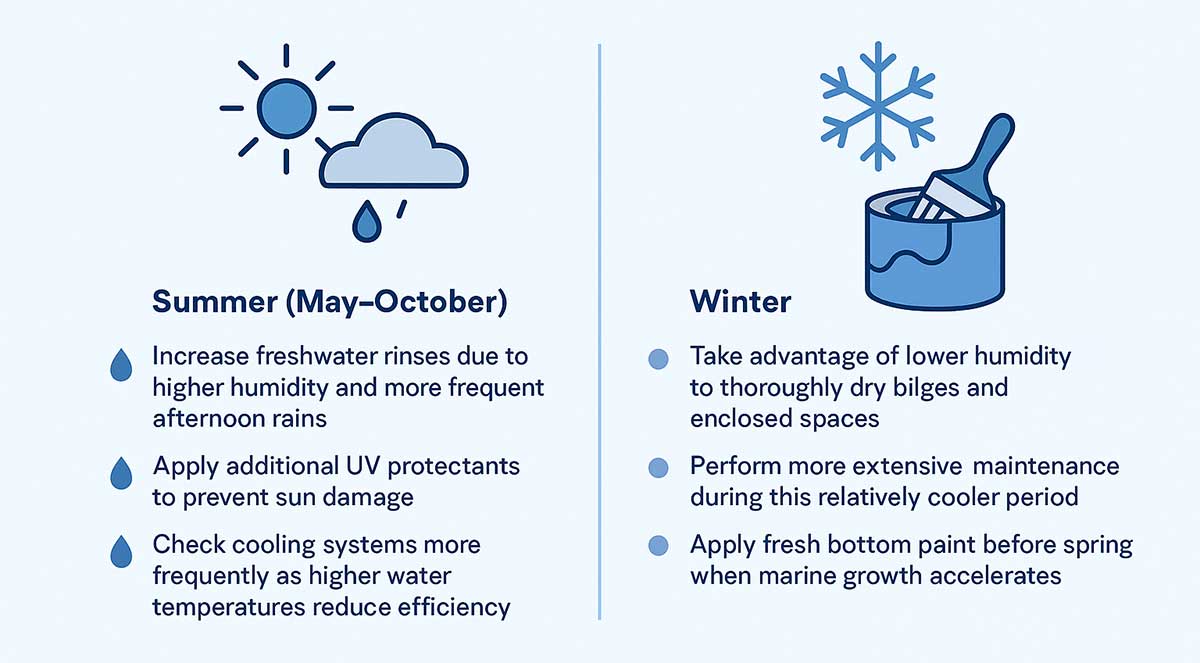
While South Florida doesn't have the dramatic seasonal changes that force northern boaters into winterization routines, we do have subtle seasonal variations that smart boaters plan for:
Summer (May-October)
- Increase freshwater rinses due to higher humidity and more frequent afternoon rains
- Apply additional UV protectants to prevent sun damage
- Check cooling systems more frequently as higher water temperatures reduce efficiency
Winter (November-April)
- Take advantage of lower humidity to thoroughly dry bilges and enclosed spaces
- Perform more extensive maintenance during this relatively cooler period
- Apply fresh bottom paint before spring when marine growth accelerates
Even in our year-round boating climate, these seasonal adjustments help address the changing conditions that affect how saltwater interacts with your boat. Learn more about the best times for boat maintenance in Miami to optimize your maintenance schedule.
When to Call the Professionals
While regular DIY maintenance is essential, certain checks and services require professional expertise:
- Engine service every 100 hours or annually (whichever comes first)
- Complete electrical system inspection annually
- Professional bottom cleaning and zinc replacement quarterly if kept in water
- Fuel system inspection and treatment every six months
- Steering and control system professional inspection annually
For boats used in Miami's waters, these professional service intervals should be considered the minimum. Heavier use or offshore running may necessitate more frequent professional attention.
What You Can Do Yourself vs. Professional Help
Finding the right balance between DIY maintenance and professional service is key to cost-effective protection. As a general rule:
- Handle routine cleaning, rinsing, and visual inspections yourself
- Learn to perform basic zinc replacements and rust treatment applications
- Leave engine internals, electrical system repairs, and structural issues to professionals
This balanced approach gives you the best of both worlds, the cost savings of handling routine maintenance yourself, with the security of professional expertise for more complex systems. When professional help is needed, our mobile marine mechanic service in Miami can come directly to your boat, saving you time and hassle.
Advanced Protection Technologies
Beyond the basics, several cutting-edge technologies can provide superior protection against saltwater's effects. These advanced solutions are particularly valuable for boats used extensively in South Florida's harsh marine environment.
New Coatings That Beat Traditional Wax
Traditional waxes and polishes have their place, but modern ceramic coatings offer dramatically improved protection. These silicon dioxide-based products create a tiny barrier that repels water, prevents salt adhesion, and resists UV damage. While more expensive initially, their longevity (often 1-2 years per application) makes them cost-effective over time.
For boats used in the waters off Miami Beach and Key Biscayne, where sun exposure is intense year-round, these advanced coatings provide dual protection against both saltwater and UV radiation. The water-repelling properties also make regular cleaning easier, as salt and contaminants rinse away more readily.
Electronic Systems That Fight Corrosion
Impressed current cathodic protection (ICCP) systems take zinc protection to the next level. These systems use a small electrical current to protect underwater metals more effectively than passive zinc anodes alone. While more common on larger vessels, smaller versions are becoming available for recreational boats.
For vessels kept in the water year-round in marinas from West Palm Beach to Miami, these systems can dramatically extend the life of underwater components. The initial investment of $1,500-$3,000 is significant, but the reduction in underwater maintenance costs and extended component life make them worth considering for serious boaters.
Monitoring Systems That Catch Problems Early
Modern monitoring technologies allow you to detect saltwater intrusion before visible damage occurs. Humidity sensors in enclosed spaces, bilge areas, and electrical compartments can alert you to moisture problems. More advanced systems can even monitor the condition of your anodes and alert you when replacement is needed.
These systems are particularly valuable for boat owners who can't check their vessels frequently. If you keep your boat in Miami but don't live locally, remote monitoring provides peace of mind and early warning of developing issues.
Special Materials Made for Saltwater
Boat manufacturers and aftermarket suppliers now offer components specifically designed for extreme saltwater environments. From specially formulated alloys for underwater hardware to composite materials that replace traditional rust-prone metals, these specialized materials can dramatically reduce maintenance needs.
When replacing components damaged by saltwater, consider upgrading to these saltwater-specific versions rather than simply replacing with standard parts. The additional cost upfront typically pays dividends in extended service life, especially in South Florida waters.
Making Smart Choices About Protection
Not all advanced protection technologies make financial sense for every boat. Consider these factors when evaluating more expensive protection options:
- How frequently is your boat used in saltwater?
- Is it kept in the water or trailered after use?
- How long do you plan to keep the boat?
- What is the replacement cost of the components being protected?
For a weekend boater with a trailered center console used occasionally in Miami waters, basic protection may be sufficient. For someone with a cabin cruiser kept in the water year-round at a Key Biscayne marina, investing in advanced protection technologies often makes financial sense over the long term.
When to Seek Professional Help
Even with diligent maintenance, there comes a time when professional intervention is necessary. Knowing when to call in the experts can save you time, money, and potential safety issues.
Warning Signs That Need Immediate Attention
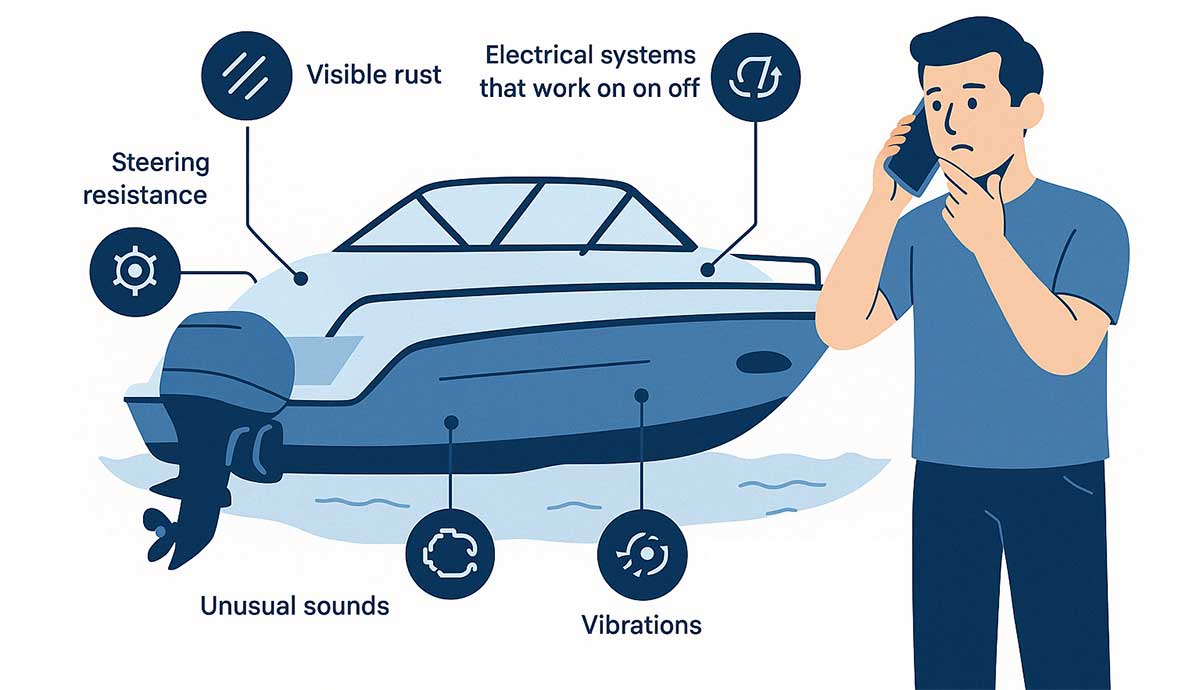
Certain signs should trigger an immediate call to a marine professional:
- Visible rust that goes beyond the surface
- Electrical systems that work on and off or not at all
- Steering resistance or unusual play in the wheel
- Engine performance issues that develop suddenly
- Unusual sounds, particularly grinding or clicking
- Vibrations that weren't there before
These symptoms often indicate problems that have progressed beyond the point where DIY solutions are effective. In the waters around North Miami Beach and Fort Lauderdale, where boating traffic is heavy and conditions can change quickly, addressing these issues promptly is a matter of safety, not just convenience.
When you need immediate assistance, our on-site boat repair service can quickly address these warning sign issues before they become more serious problems.
Finding Experts for Different Saltwater Problems
Not all marine professionals have the same expertise. Depending on the nature of your saltwater damage, you may need a specialist:
- Marine electricians for rust-related electrical issues
- Fiberglass experts for hull blistering and structural concerns
- Certified mechanics for engine and mechanical system damage
- Corrosion specialists for extensive metal deterioration
- Marine surveyors for comprehensive damage assessment
In South Florida's boating community, word-of-mouth recommendations are invaluable. Ask fellow boaters at your marina who they trust with saltwater-related issues. The best professionals often have waiting lists, a good sign they're worth waiting for.
If you're looking for reliable service providers, check out our guide to the best boat mechanics in South Florida who specialize in saltwater-related issues.
Questions to Ask When Hiring Help
When saltwater damage requires professional help, asking the right questions helps ensure quality service:
- What experience do you have with this specific type of saltwater damage?
- Do you have references from other boat owners with similar issues?
- What preventive measures do you recommend to prevent it happening again?
- Will you provide documentation of all work performed?
- Do you offer any warranty on your repairs?
Quality marine professionals in Miami and surrounding areas will welcome these questions and provide clear, detailed answers. If you sense hesitation or vagueness, continue your search.
Getting Your Boat Ready for Service
When you do need professional help, proper preparation saves time and money:
- Document the issue with photos and videos
- Note when you first noticed the problem
- List any changes in boat use or maintenance that preceded the issue
- Clean the boat thoroughly so technicians can focus on the problem
- Prepare a list of any other concerns you'd like addressed while the boat is being serviced
This preparation helps professionals diagnose issues more quickly and accurately, reducing labor costs and ensuring all concerns are addressed.
Why Preventive Checkups Save Money
Rather than waiting for problems to develop, consider scheduling annual professional assessments specifically focused on saltwater damage. These preventive check-ups typically cost $200-$400 but can identify developing issues before they become expensive emergencies.
For boats used regularly in the waters around Palm Beach and Miami, these professional assessments are particularly valuable during the second and third years of ownership, when factory protections have diminished but problems may not yet be visible to the untrained eye.
Not sure where to get your boat serviced? Our guide on where to fix your boat in South Florida can help you find the right facility for your specific needs.
Key Takeaways
- Saltwater is 800 times more corrosive than fresh water - making boats in South Florida waters especially vulnerable to damage.
- Metal parts, electrical systems, and engines - are the most at-risk areas that need regular attention.
- Early warning signs - include discoloration around fittings, stiff controls, and unusual sounds that shouldn't be ignored.
- Regular maintenance saves money - every dollar spent on prevention saves about seven dollars in future repairs.
- Proper protection extends boat life - and maintains both performance and resale value in Miami's harsh marine environment.
Smooth Sailing in South Florida Waters

Living in South Florida means enjoying some of the world's most beautiful waters, from the bright blue of Miami Beach to the clear waters around Key Biscayne. But this paradise comes with a hidden cost: the constant effects of saltwater on your boat.
The good news? You now understand what you're up against. Saltwater damage isn't inevitable, it's manageable with the right knowledge and consistent care. The small investments of time and money in preventive maintenance pay huge dividends in your boat's longevity, performance, and value.
Remember that every boat and boating pattern is different. A weekend warrior launching from a trailer in Fort Lauderdale faces different challenges than someone with a vessel moored year-round in North Miami Beach. Adjust your protection strategy to your specific situation, focusing on the areas most vulnerable to your particular use pattern.
When you do need help, don't hesitate to reach out to professionals who understand the unique challenges of South Florida's marine environment. Our team at Boat Repair Miami has spent years helping boaters protect their investments from saltwater's effects. Whether you need advice on preventive measures or help addressing existing damage, we're just a message away: Request Boat Repair or Service Now





.png)